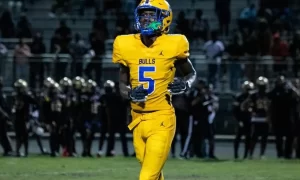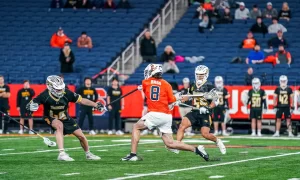Evolution of Three-Point Shooting
The NBA introduced the three-point line in the 1979-80 season, and it has drastically changed team dynamics and strategies. Early on, teams attempted fewer than ten three-pointers per game. By the 1999-2000 season, the average attempts had risen to 13.7 per game. This trend continued its upward trajectory, and by the 2023-24 season, the Los Angeles Lakers, the team with the fewest attempts, averaged 30.4 three-point shots per game.
This evolution has been influenced by several teams and key players. The Golden State Warriors played a pivotal role in this transition during the mid-2010s. Led by Stephen Curry and Klay Thompson, the Warriors dominated the league with their three-point shooting proficiency. In the 2015-16 season, they made 41.6% of their three-point attempts on 31.6 attempts per game, setting a standard for other teams to follow.
Defensive Adjustments and Metrics
As the three-point shot became more critical, defensive strategies had to evolve. Many teams now focus on both limiting three-point attempts and improving rim protection. For instance, the Milwaukee Bucks and Toronto Raptors allow a high volume of three-point attempts while emphasizing the importance of defending shots at the rim. This strategy reflects a shift from traditional defensive schemes to more nuanced, data-driven approaches.
In the 2019-20 NBA season, for the first time in a decade of increased three-point shooting, a negative correlation was observed between points allowed per 100 possessions and opponent three-point rate. This trend continued into the 2023-24 season, where teams that shot league average or better from deep won 67.4% of their games, the highest mark in the 42-year history of the three-point line.
Defensive effectiveness involves understanding the variables that affect three-point shooting percentages. A logistic regression analysis of 32,511 NBA three-point shots identified six key factors: distance of the closest defender, time remaining on the shot clock, whether the shot was taken after a dribble or catch, game period, shot distance, and venue. These insights inform teams on how to position their defenders and anticipate offensive moves.
Economic Value and Strategic Adjustments
Three-pointers, though prolific, have seen a relative decline in their expected value since the 2017-18 season due to improvements in defensive strategies. This phenomenon, akin to “sports deflation,” suggests that while three-pointers remain a substantial part of the game, their marginal utility has decreased as defenses adapt.
Teams like the Denver Nuggets have operationalized unique defensive strategies, especially in pick-and-roll situations. Instead of dropping back, which was common in traditional defenses, the Nuggets have their big men defend at the level of the screen. This approach requires significant effort and coordination from weak-side defenders but has proven effective. The team ranked second in the fewest three-pointers allowed in the 2023-24 season, illustrating the potency of their strategy.
Data’s Role in Modern Defenses
The proliferation of sports betting has further influenced how defensive strategies are analyzed and implemented. Platforms for online casino apps provide detailed data relevant to both bettors and professional teams. This data includes player performance metrics, situational statistics, and team trends. Coaches leverage these insights to refine their defensive schemes, aiming to counter specific offensive patterns.
This data-centric approach is not limited to the professional sphere; fans and analysts use similar metrics to discuss team performances and strategies. For example, debates about a team’s effectiveness against high-volume three-point shooters or their ability to manage rapid transitions often parallel coaching strategies. Thus, sports betting data enriches public understanding of the game while simultaneously reflecting and sometimes enhancing professional methodologies.
Statistical Trends and Predictive Factors
In the 2023-24 NBA season, teams averaged a record 12.8 made three-pointers per game, with a league-wide three-point shooting percentage of 36.6%, the fourth-highest in history. The Boston Celtics led with 16.2 made three-pointers per game on 42.9 attempts, while the Detroit Pistons were last with 11.1 made three-pointers on 31.1 attempts.
Advanced analytics have played a crucial role in identifying impactful strategies. Teams have discovered that increasing the percentage of opponent shots taken within three feet of the rim tends to decrease opponent three-point percentages. Conversely, higher percentages of midrange shots correlate with increased opponent three-point efficiency.
Adaptation of Player and Team Strategies
Players have adapted to the evolving landscape by incorporating more long-distance shots and improving their overall shooting skills. This change necessitates that even non-traditional shooters become proficient from beyond the arc. The modern player must balance shooting ability with other skills to secure minutes on the court.
An example of strategic adaptation is the Houston Rockets, which focused on minimizing midrange shots from 2013-2020. This approach, known as “Moreyball,” emphasized three-pointers and layups. While it led to offensive success, it also underlined the risks of relying too heavily on three-point shots, particularly evident when the Rockets missed 27 consecutive three-point attempts in a critical playoff game against the Warriors.
Coaching Perspectives and Strategic Imperatives
LeBron James has noted the importance of adjusting defensive strategies to the specific contexts of each game. It’s impossible to defend all aspects of an opponent’s offense simultaneously, so teams must prioritize specific areas. Meanwhile, Bam Adebayo emphasizes making shots difficult for shooters, recognizing the high talent level in the league.
Giannis Antetokounmpo points out the increasing range from which players are effective, making defense more challenging. This observation aligns with the broader trend of players attempting more shots from longer distances compared to previous eras. The 2023-24 season underscored this shift with the fewest fouls per game (18.7) and the second-fewest free throw attempts (21.7) in league history, indicating a focus on contesting shots without fouling.
As the NBA continues to evolve, defending the three-point shot remains a complex and crucial aspect of the game. Teams will need to continuously adapt their strategies, leveraging data and player versatility to remain competitive in a league where the three-point shot has become a defining feature.
















